In the paleo-Christian era another trope referencing salvation through Christ was the cross placed on a hill from which four rivers flow, as in this sarcophagus and this diptych leaf. The rivers represent the four rivers in Genesis 2:10-14 that rise from the single source in Eden.2
Later, in the Baroque, Christ's glorification by the Father is pictured as putti lifting the Cross into the heavenly light (example). In the same period this engraving represents the cross as the "fountain of living water" (Jeremiah 2:31) that the commentators interpret as Christ (Glossa Ordinaria, IV, 595). The chi-rho combines the first two letters of Greek XPΙΣΤOς, "Christ." In paleo-Christian art it usually represents the resurrected Christ and is often pictured within a wreath, as in the first picture at right. In paleo-Christian images, it may be flanked by birds (as in the picture) or by lambs (example). Birds, symbolic of immortality from classical times, can represent Christians' hope for their own resurrection. Lambs may have the same meaning but can also represent the apostles, as in these sarcophagus fragments, where twelve lambs are labeled with the apostles' names. Or a lamb representing Christ may have a chi-rho inscribed on its halo (example).
By the end of the last century the chi-rho had become simply a symbol of Christ or of Christianity in general.
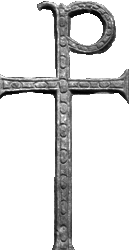 To represent Christ specifically as crucified on the cross without actually picturing him, paleo-Christian artists used the staurogram, the figure shown at left. The staurogram originated as a scribal abbreviation for the words "cross" and "crucify." For its subsequent development, see my page on this early symbol.
In the first centuries A.D.,
the anchor symbol
sometimes served as an alternative to the cross as an identifier of Christianity (Sill, 128). This was partly because of its cross-like shape and partly because Hebrews 6:19 speaks of hope in God's promise as "an anchor of the soul." In medieval times hope was the more common meaning of the anchor symbol, but even then it could be associated iconographically with Christ in the Eucharist, as in
this altar frontal from the 12th century and
this manuscript illustration from the 15th.
To represent Christ specifically as crucified on the cross without actually picturing him, paleo-Christian artists used the staurogram, the figure shown at left. The staurogram originated as a scribal abbreviation for the words "cross" and "crucify." For its subsequent development, see my page on this early symbol.
In the first centuries A.D.,
the anchor symbol
sometimes served as an alternative to the cross as an identifier of Christianity (Sill, 128). This was partly because of its cross-like shape and partly because Hebrews 6:19 speaks of hope in God's promise as "an anchor of the soul." In medieval times hope was the more common meaning of the anchor symbol, but even then it could be associated iconographically with Christ in the Eucharist, as in
this altar frontal from the 12th century and
this manuscript illustration from the 15th.
(The anchor is also an attribute of St. Clement.)
THE SIGN OF THE CROSS
In modern times Catholic and Orthodox Christians will often be seen making "the sign of the cross," touching first the forehead, then the breast or midsection, then each shoulder in turn. In early Chistianity the usual gesture was to make a cross on one's forehead with the thumb. In addition to the obvious similarity to Christ's cross, this mark was based on Ezekiel 9:4, "And the Lord said to him: Go through the midst of the city, through the midst of Jerusalem: and mark Thau [i.e. the Hebrew letter ח] upon the foreheads of the men that sigh, and mourn for all the abominations that are committed in the midst thereof." The ח was equivalent to the Greek letter tau (T), which Tertullian called "the sign on our foreheads in the true catholic Jerusalem."3 In the 5th century the Church promulgated the definition of Christ as "true man and true God," a single person with two distinct natures. Consequently, the crucifixes of the next five centuries expressed his divine nature by portraying him as priest and king – crowned and wearing liturgical vestments, as in the second picture at right.4 In these images his eyes are usually open and he is clearly alive. The arms do not bend with the weight of his body but stretch out vertically, suggesting the exuberance of victory or even welcome to the viewer. The same iconography applied to Crucifixion scenes, as discussed in our page, "The Crucifixion in Art." It also inspired the Anglo-Saxon "Dream of the Rood," a poem where the Cross appears to the speaker as both a bejeweled treasure and a symbol of anguish.6In the Romanesque period, roughly the 10th through the 12th centuries, the colobium is gradually replaced by a finely decorated skirt and most of the body is left naked, as in the third picture at right. A slight bend in the arms makes the figure more realistic but does not imply that they are bending in response to the weight of a dead body. Indeed, the Jesus on most Romanesque crucifixes continues to be very much alive, with head erect and eyes open. Generally we do not see a wound in his side.
An interesting example, reputed to be the oldest cruceiro in Galicia, has the old colobium version on one side of the cross and the new skirted version on the other.
In the Gothic period (13th through 15th centuries) crucifixes emphasize the torments Jesus suffered, with very literal detailing of his wounds and bruises, as in the third picture at right. The man is clearly dead, his head slumped to the side and blood flowing from the wound in his side. Instead of a skirt, an unadorned cloth is tied around his waist. Whereas the older works emphasized his status as king and priest, the Gothic points to his role as redeemer. In the fourth picture at right, this is suggested by John's gesture of contemplation and the portrait at the top of St. Michael, the victor over Satan, whose shield bears a cross in the shape of this very crucifix. In another example the redemption is symbolized by a pelican, believed at the time to bring its young back to life with its own blood. (See my page on the pelican symbol.)
The emphasis on Jesus' suffering continued into Counter-Reformation art in the 16th and 17th centuries (example) and thence into the folk art of Latin countries, where it is still in evidence (example). Some examples go back to using a decorated skirt rather than a tied cloth (example).
Later crucifixes retain the Gothic elements – the five wounds, the tied cloth, and the slumping head and sagging arms. But most examples from the 19th and 20th centuries, like the fifth picture at right, are considerably less bloody, and even in New Mexico this unsorrowful crucifix has Christ open-eyed and raising his arms in acclamation. Modern crucifixes are usually less oriented to theological statement, although a few examples have Jesus reaching one hand down from the cross as if to assist the person standing below (example).
THE PARTS OF THE CRUCIFIX
The INRI Scroll
At the top of the vertical crosspiece one often sees a scroll or plaque bearing the letters INRI, which stand for Iesus Nazarenus Rex Iudeorum, "Jesus of Nazareth, King of the Jews." The Roman practice was to use such a scroll to identify the criminal and his crime (see John 19:19-22). On larger crucifixes the scrolls will sometimes have the entire inscription (example).The Suppedaneum
Christian writers of the period of the persecutions mention a sedilus excessus in Christ's cross, a projection functioning as a small seat to keep the weight of the body from pulling the hands off the nails. To my knowledge this feature was never represented in the art, but many crucifixes have a suppedaneum, a sloping ledge to support Christ's feet. (See the fourth picture at right.) This is mentioned in Gregory of Tours' Glory of the Martyrs (6th century).The Nails
Debunkers will sometimes declare that nails could not have been driven through Christ's palms as shown in crucifixes, because of the pull of the body. But the usual Roman practice, well attested in the literature, was to tie the limbs to the cross and then drive nails through the hands and feet. The earliest known Christian image of the crucifixion, from a time not long after the era of public crucifixions, clearly shows nails driven through the palms. A crucifix made for a liturgical procession is called a "processional cross." There may be secondary images of saints on the ends of the crosspieces and/or flanking the corpus (example). Holy Week processions in Latin countries feature life-size crucifixes; some churches will keep such a crucifix in a display case during the rest of the year (example) or place the corpus in a glass-sided coffin (example).Before the modern age it was common in Catholic countries to maintain crucifixes at public crossroads for the edification of travelers, and some of these are still extant today. They are known in Spain as cruceiros (example). and in France as Calvaires (example). Some of these manage to express profound theological insights. The iconography of the calvaire in Espalion, France, for example, merges imagery of the Crucifixion with both the Eucharist and the Resurrection / Ascension.
In parts of southern Europe the Virgin Mary is an important feature of wayside crosses. In Croatian examples she stands alone before the Cross and faces the viewer (example). In a Munich church we observed a similar arrangement in which a statue of Our Lady of Sorrows is placed below and in front of a painting of the crucified Christ. Mary is also featured, as the Madonna with the child Jesus, on the reverse of a pectoral cross in Zadar Cathedral.6 Even as far back as the 7th/8th century an orant Virgin was represented on the reverse of an Eastern pectoral cross.7
In Armenia, the cross is inscribed on stone tablets called khatchkars, which serve as memorials and as historical markers (example).
Finally, there is a type of crucifix or crucifixion image in which the souls in Purgatory are pictured beneath the base of the cross. See this section of our study of the "Descent into Hell."
SPECIAL VENERATION
Some crucifixes are the object of special veneration, such as the Señor de Esquipulas in Guatemala and Nuestro Señor de los Milagros in Peru.For a more extensive scholarly treatment of this subject, see the article in the Catholic Encyclopedia.
Prepared in 2016 by Richard Stracke, Emeritus Professor of English, Augusta University.
HOME PAGE
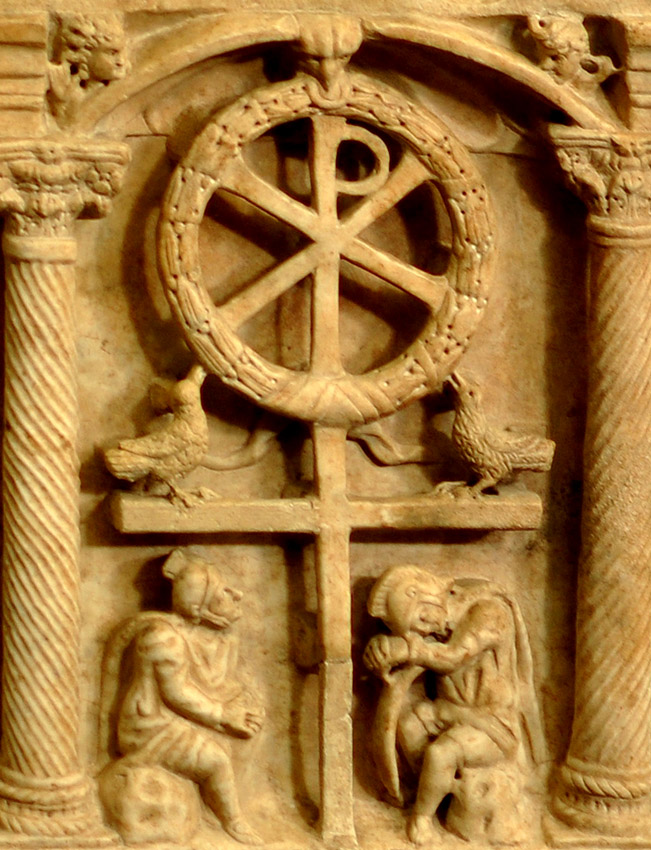
Paleo-Christian: No crucifixes are extant from the first four centuries, only crosses that stood in for representations of Christ, as in this image symbolizing his death and resurrection. (See the description page.)
6th-10 centuries: Christ as Priest and King. In the "Lucca Crucifix" (8th century) a living Christ with arms extended wears priestly garments and a royal crown. (See the description page.)
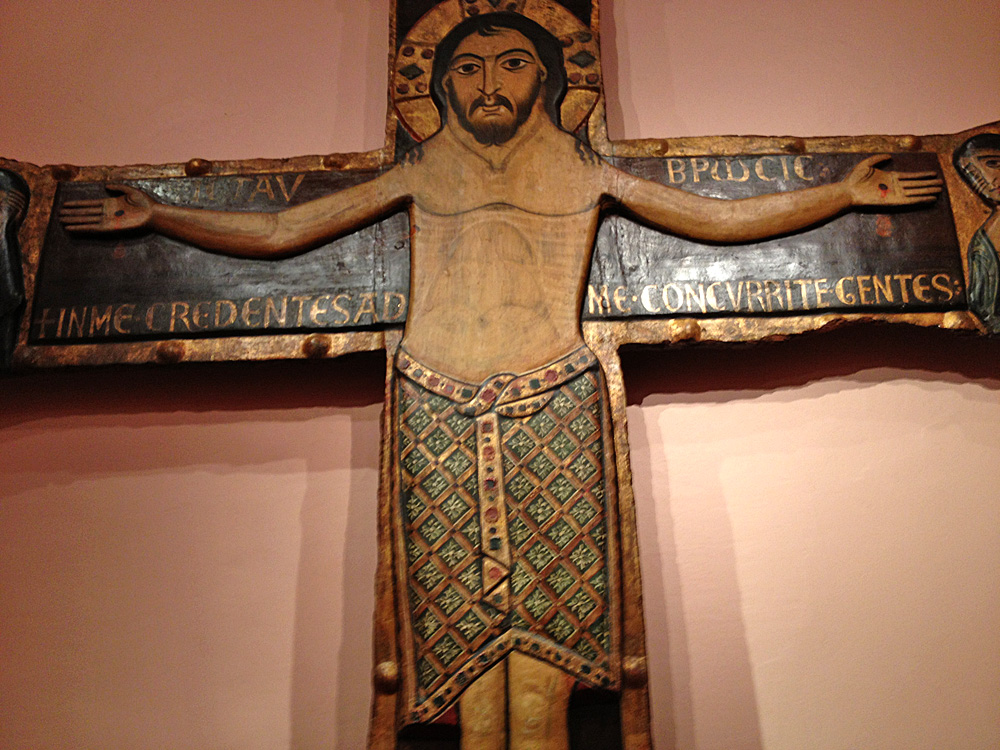
Romanesque: Jesus is alive but wears only a skirt. The arms bend but do not sag from the weight of the body. (See the description page.)
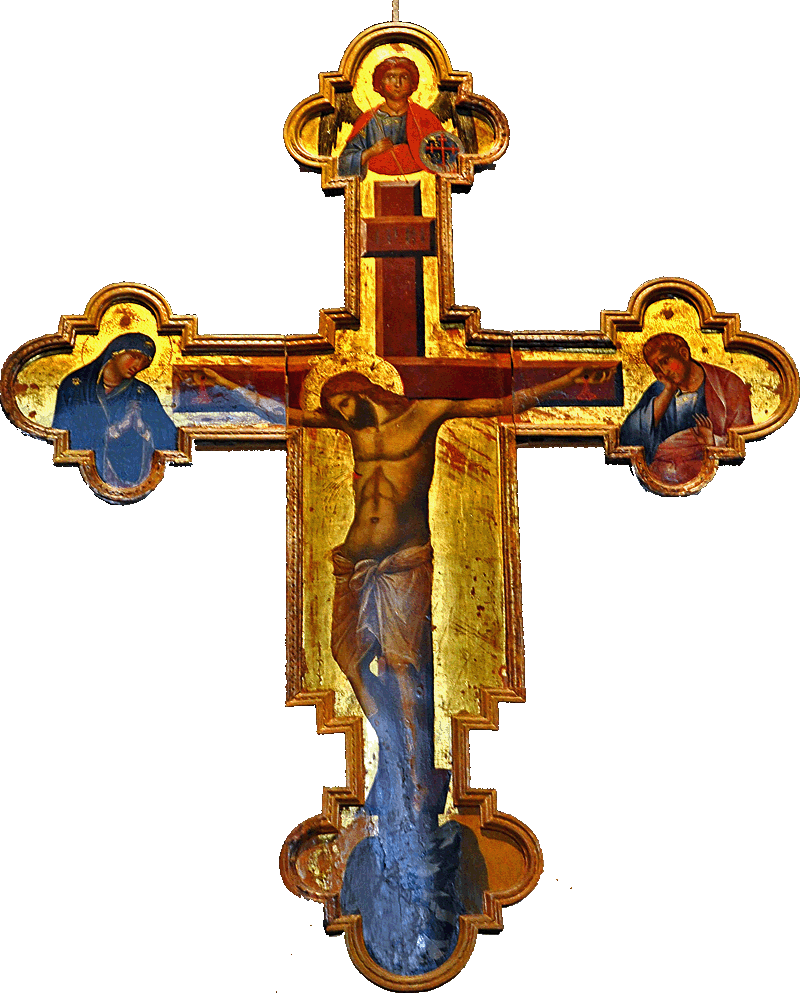
Gothic period: Jesus is dead. The arms sag from the weight of the body, and blood flows from all five wounds. A simple cloth girds his waist. (See the description page.)
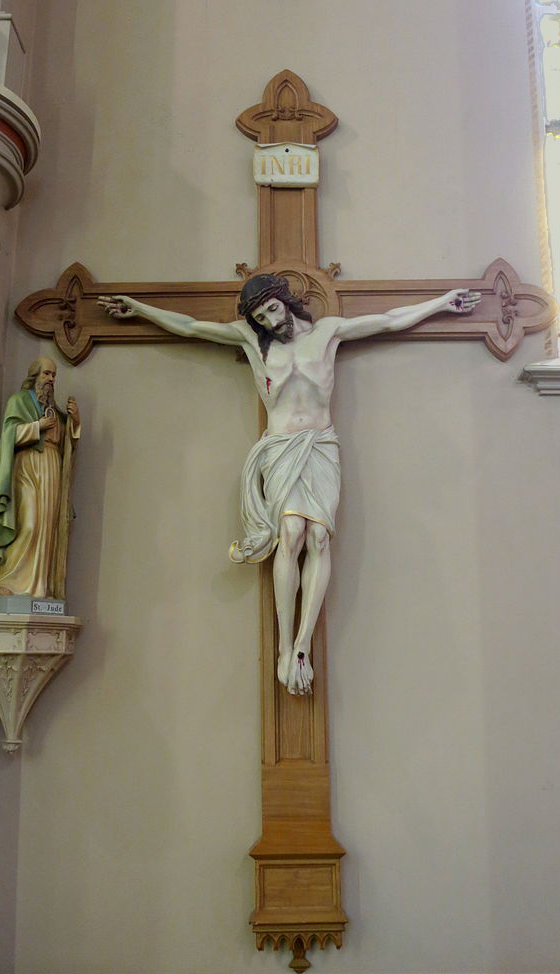
Contemporary crucifixes follow the Gothic but with less blood. (See the description page.)
MORE CRUCIFIXES
- 1018-26: An embossed crucifix on the cover of a Milanese evangeliary is Romanesque in detail but anticipates the Gothic emphasis on the pathos of Christ's Passion.
- 13th century: In this Croatian crucifix there are no nail marks on the feet and no wound in the side.
- 13th century: A transitional example, with elements of both Romanesque and Gothic styles.
- Gothic: Nave crucifix with a pelican above the head and the four beasts representing evangelists at the ends.
- 14th/15th century: A Crucifix in Poreč, Croatia – with Gothic pathos but straight arms and a skirt.
- 15th century: Painted Crucifix with a pelican, in Urbino's Ducal Palace.
- Early 16th century: Pietro Ruzzolone, Painted cross
- 16th century: Crucifix display case from Oaxaca, Mexico.
- 16th century: A painted crucifix emphasizing the redemptive character of Christ's sacrifice.
- 17th century: Crucifix, also from Oaxaca.
- 1679: Representing the person of Christ, the Cross is lifted to Heaven in this dome fresco in the Gesù in Rome.
- 1683: Villalpando's grand canvas, Moses and the Brazen Serpent and the Transfiguration of Jesus, relates those two themes to the Cross, which is pictured with hyssop and other emblems of the Passion of Christ.
- 1684: At San Ignazio, Rome, yet another Triumph of the Cross representing the Father's glorification of Christ.
- 1706: A Mexican allegorical painting of the cross as the Tree of Life.
- 19th century: A Crucifix in Switzerland that harks back to the earlier emphasis on pathos in presenting the crucified Christ.
- 20th century: Jesus reaches down from a crucifix on the pilgrimage route to Santiago, Spain.
- Undated: A typical crucifix in a French church, possibly from the 17th or 18th century.
- Undated: A cruceiro in Sarria, Spain.
MORE CROSSES
- Mid-4th century: Another sarcophagus with the soldiers of the resurrection accounts beneath the chi-rho wreath.
- 5th century: Mosaic in Rome's Santa Maria Maggiore: God represented as a jeweled cross on a jeweled throne.
- 5th-6th century: The chi-rho was often inscribed on oil lamps such as this one in a museum in Syracuse, Sicily.
- 5th-6th century: Another oil lamp, from Dalmatia, with a man worshiping the Cross.
- 6th century: Cross symbolizing Christ as Salus Mundi, "Savior of the World."
- 6th century: Cross and bird motif in San Vitale, Ravenna.
- 9th century: Croatian gable with a relief of a cross flanked by two peacocks.
- Undated (paleo-Christian?): Fragments of a cross-and-peacock motif affixed to the wall of the atrium, Poreč Basilica, Croatia.
- Early 12th century: The cross and a human figure of Christ are merged in this detail from the St. Foy West Tympanum.
- Circa 1220: A late example of a cross representing the person of Christ at St. Paul Outside the Walls, Rome.
- 1686-88: Vault fresco in Seville, Spain.
MIRACLES OF THE CROSS
- 16th century: A panel from a predella illustrating the "Legend of the Crucifix of Beirut."
DATES
- The Feast of the Exaltation of the Cross is on September 14.
ALSO SEE
- R. M. Jensen's remarks on the cross in Understanding Early Christian Art, 137-141.
- St. Helena, said to have recovered the True Cross in the 4th century
- For the Feast of the Exaltation of the Cross, see the Golden Legend #137: html or pdf.
NOTES
1 Oxford Dictionary of Christian Art, s.v. "Birds, symbolic." In City of God, XXI, 4, Augustine describes a little experiment he conducted that confirmed that roasted peacock was remarkably resistant to corruption.
2 See this note at my study, "Stags at Fountains, Peacocks, Kantharoi."
3 Jensen, Understanding Early Christian Art, 137-38.
4 Ladner, 33-34.
5 A number of translations of the "Dream of the Rood" are available online. See Garnett for one. The original Old English can be found here at Wikisource.org.
6 Petricioli, 59. Molded silver pectoral cross, by a Zadar goldsmith in the 15th century. Now in the treasury of Zadar Cathedral.
7 Petricioli, 58. Pectoral reliquary cross, 7th or 8th century, from Palestine or Egypt. Bronze, molded and gilded. In the Convent of St. Mary, Zadar.